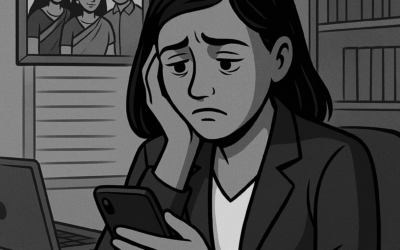Monoculture – not the most common of words, but one which you do hear nowadays from time to time, usually in texts about the present consumerist culture we live in. Sounds fancy, doesn’t it? But what does it really mean? On the face of it, this seems obvious: mono = one and culture = the ways of living and worldviews of a particular group of people. So it implies we are now living in a single culture, right? Much like the single varieties of crops you see stretching out across hectare after hectare in modern industrial farms. Well, not quite. You see, a casual look around the world we live in will show you how wrong this is – there is still plenty of variation in the foods we eat, the customary clothes we wear, the festivals and rituals we celebrate and observe, etc. And it doesn’t look like they’re all dying off either.
There are some stark examples of the more visible monoculture-isation – the rate of language diversity loss, for example, where we’re actually losing our heritage of lingual diversity faster even than our natural species diversity and also the fact that many, but not all, of those rituals and festivals are indeed dying away.
Meanwhile, new cultural advancements are being made as well, perhaps at a faster rate now than before, partly as genuine new trends, but also largely due to the fusion of various existing cultural influences that happens much more now than ever before; my favourite example of this is the recent trend in India to combine the traditional kurta/kurti with jeans as opposed to the previous accompaniment of pyjamas. So are the opponents of the monoculture simply inventing a problem where none exists?
Nope. I don’t think so, at least. The reason is because there’s diversity and then there’s diversity. I tend to divide diversity into two types – surface diversity and what you may call deep diversity (credits to Yogendra Yadav for giving me that phrase). The best way to illustrate what these are is through examples – surface diversity includes all the various cuisines, rituals, festivals, dresses and other obvious signs that we take as proof that diversity is alive and well. This isn’t entirely true since a lot of these are disappearing too – we don’t notice that because their diversity isn’t reducing down to just one version, but rather a few hundred. Some cultural icons are thriving – a good example is the festival of Diwali, which is more popular now than ever before.
For every Diwali, there are scores of other tribal and other small community festivals that have disappeared. A few hundred different cultural practices is still a much smaller pool than the thousands that existed prior to the rapid spread of the modern world into the old one.
So what is deep diversity then? Basically, it is the collection of fundamentally different world views and approaches to life that are part of the collective psyche of a people. There has always been a lot more surface diversity than deep diversity, for it is much easier to think of a new dress design than an entirely new philosophy. But, unlike how surface diversity is being reduced to a few hundred variations, we may indeed be reducing the number of fundamentally different viewpoints down to just one – hence the term monoculture. Allow me to provide a couple of examples of some truly ‘deep’ differences in cultural outlooks.
The Amandawa tribe are an until-recently isolated tribe hailing from the depths of the Amazonian jungle in Brazil. They were first contacted by the Brazilian govt. in 1984. Ethnologists and anthropologists always get excited when they get access to a new tribe like this and the Amazonian rainforest is particularly popular hunting ground (pardon the pun) of theirs. But there are also sometimes other researchers who take an interest in such things. In this case, it was a pairing of a psychologist and a linguist who decided they wished to study the Amandawa language, for language has long been one way of understanding the individual as well as cultural mindset.

One of the most fascinating things they discovered is the Amandawa approach to the concept of ‘time’ – they literally had no word for it! And not just no word, but no concept of time itself in an abstract sense. Ask an Amandawa man to translate the word time into his language and he might translate is as ‘sun’ or ‘summer’ or some other such event. In other words, these people (who had no clocks – not even a sundial – or calendars of any kind) only cared for the contents of a particular period rather than its spacial position or location i.e. they didn’t care WHEN something happened, only WHAT actually happened.
You could ask them about their childhood and they’d tell you about what they did, but without using any of the familiar time-related words we use in everyday speech such as ‘when’, ‘before’, ‘during’, etc. Try doing that yourself and see how tricky it is. It wasn’t just a facet of their language either – as a culture they literally did not have a concept of time in an abstract sense. In one experiment, Amandawa tribes people were given sets of plates and asked to arrange them in order to show their lives. You or I might arrange them in sets of 7 for the week or 12 for the months or perhaps in a circle to show the hours of a day. But the Amandawa didn’t arrange them in any particular order. They just scattered them about randomly and then told a story about each plate – one plate signified summer and they would describe what actually happened in summer, another (not in any sequence in relation to summer) might signify the monsoon and they would explain what happened then, etc. The order or arrangement of events was something they were supremely indifferent to.
In our modern world, we could never live like this. Too many of our systems – and too much of our lives – literally depend on keeping time in an abstract sense. But the Amandawa people show that there’s more than one way to understand time. We think of beginnings, middles and ends. They think of happenings, contents and changes.
Another example of deep diversity that is quite popular on the internet is the difference in the concept of ‘self’ – and its accompanying value system – between our modern outlook and that of various tribal cultures that have been studied over the years. In some tribes, there is a very strong inculcation of a common cultural identity – even to the extent of cancelling out the concept of separation as an individual. It is important not to overstate this, as the internet is fond of doing (which is why I wished to use the Amandawa as my primary example). But it is true that, for example, if you were to give a single member of such a tribe a gift of a large amount of food (or some other resource that is valuable to them), then they often immediately take off to share it with the rest of their people.
This isn’t generosity or charity as we usually perceive it. The tribesman isn’t being ‘nice’. Charity and compassion necessarily implies separation between giver and receiver – ‘you’ care about ‘someone else’. In the case of the tribesman, he simply doesn’t see any difference between his interests and the interests of his tribe. That’s just his automatic reaction. Indeed, these tribes aren’t at all about sweetness and love – many of them are warrior cultures and are quite brutal to outsiders that they decide are enemies.
The modern world is decidedly designed around a particularly individualist conception of the self and its place in society. Imagine if such a fundamentally collectivist ‘outlook’ (as opposed to the forcibly collectivist communist ‘system’ or morally collectivist religious ‘doctrines’) were to predominate in society. Needless to say, our world would look very different indeed, if it could even work at all. My point, however, has not been to campaign for one way of looking at the world over another, but rather to show that there are some differences that run deeper than others and can’t be reconciled easily.
It is these deeply diverse viewpoints that we are rapidly losing nowadays. Surface diversity is reducing too, but not down to just one common culture. This is because it is relatively easy to incorporate many of these surface differences, provided they have a certain potential for fitting into our current world system. Diwali, for instance, has been successfully commercialized owing to both its existing popularity (and obvious potential for more popularity) and it’s ‘celebration mechanism’ i.e. fireworks, which lots of folk love and which also have business potential. Even here, the nature of the festival has changed – the fireworks are over-emphasized while the other practices are often given less importance than before (fireworks weren’t even part of Diwali when it was first celebrated, only the lighting of diyas was).
Other festivals have virtually disappeared because they didn’t have such commercial potential and lacked a large enough existing customer base i.e. they were too small and niche. Other differences, like food and dress, are similarly easy to fit into our new world. The new cultural trends (like that kurta-jeans combo, or fusion music), meanwhile, are usually already fully integrated into the over-arching consumerist society and system we live in and under. They don’t threaten the status quo – indeed, they often even advance it.
But most deeply different viewpoints are pretty much impossible to incorporate. The consumer culture that is often railed against isn’t about specific products like iPhones and the like. It’s about the triumph and steamrolling of one particular way of looking at and living in the world over all others. That is the monoculture. It isn’t about reducing the world to just one common grey mass, but rather about a world with a few hundred shades – hues – of grey. But ultimately, no matter how many hues it has, a rainbow composed of only grey is a pretty sad sight to see.




Then the challenge is to commercialize the less popular ones I guess… if at all, we think they are worth preserving.
And btw… Credits to Yogendra Yadav? Where are my credits? O.o
Lol. I wrote this quite some time ago, bro. And I heard that phrase from Yogendra Yadav years ago. First come, first credited… 😉
And I’m not sure if every cultural tradition is really amenable to successful commercialization, assuming their practitioners would even want that (which, in many cases, I doubt they would).
Then the challenge is to commercialize the less popular ones I guess… if at all, we think they are worth preserving.
And btw… Credits to Yogendra Yadav? Where are my credits? O.o
Lol. I wrote this quite some time ago, bro. And I heard that phrase from Yogendra Yadav years ago. First come, first credited… 😉
And I’m not sure if every cultural tradition is really amenable to successful commercialization, assuming their practitioners would even want that (which, in many cases, I doubt they would).